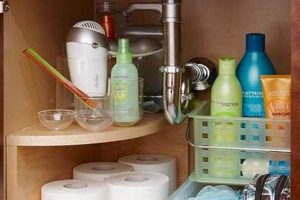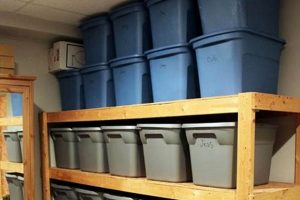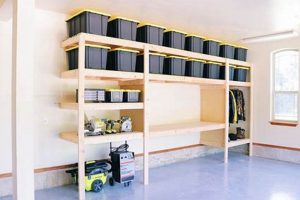The creation of weatherproof receptacles for possessions kept outside represents a growing trend in home improvement. These structures offer a practical solution for safeguarding garden tools, recreational equipment, and other items vulnerable to environmental exposure. Such constructions often involve customized designs and readily available materials to meet specific spatial constraints and aesthetic preferences.
Properly constructed, these repositories offer protection from inclement weather, deterring rust, rot, and general degradation. This preservation extends the lifespan of stored belongings, reducing replacement costs and minimizing environmental impact. Historically, rudimentary forms of exterior holding spaces have been employed for centuries, evolving alongside advancements in material science and construction techniques. The contemporary iteration blends functional utility with aesthetic considerations, enhancing the overall appeal of outdoor living areas.
The subsequent sections will delve into the critical aspects of planning, material selection, construction methods, and maintenance procedures relevant to erecting a durable and visually appealing unit. Careful consideration of these elements ensures a successful outcome, providing a valuable addition to any property.
Essential Considerations for Exterior Holding Space Construction
The following guidelines provide crucial insights for ensuring the longevity and efficacy of a self-assembled weatherproof container intended for outdoor use.
Tip 1: Foundation Preparation: Prior to construction, establish a level and stable base. A concrete slab, gravel bed, or pressure-treated lumber frame can prevent ground contact, mitigating moisture damage and pest infestation.
Tip 2: Material Selection: Opt for weather-resistant materials such as cedar, redwood, or treated lumber. These choices exhibit natural resistance to rot, insects, and moisture, extending the structure’s lifespan.
Tip 3: Proper Joinery: Employ robust joinery techniques, including screws, bolts, and waterproof adhesives. Securely fastened components withstand wind loads and prevent structural weakening over time.
Tip 4: Weatherproofing Measures: Apply a high-quality exterior-grade sealant or paint to all surfaces. This barrier protects against water penetration and UV degradation, preserving the material integrity.
Tip 5: Ventilation Design: Incorporate ventilation openings to promote airflow and reduce moisture buildup. Strategically placed vents minimize condensation and inhibit mold growth within the enclosure.
Tip 6: Drainage Solutions: Ensure adequate drainage by sloping the roof and incorporating drip edges. Proper water management prevents water from pooling and causing damage to the structure.
Tip 7: Hardware Durability: Utilize corrosion-resistant hardware, such as stainless steel or galvanized steel, for hinges, latches, and fasteners. This precaution prevents rust and ensures reliable operation in outdoor conditions.
Adherence to these recommendations facilitates the construction of a durable and functional outdoor storage solution, capable of withstanding environmental challenges and safeguarding stored items.
The subsequent sections will explore advanced techniques and design considerations for optimizing space and enhancing the aesthetic appeal of the finished product.
1. Material Weather Resistance
Material weather resistance constitutes a fundamental prerequisite for the successful construction and long-term viability of any exterior repository. The direct correlation between material durability and the protection afforded to stored items necessitates careful selection of appropriate building components. Inadequate resistance to environmental elements invariably leads to premature degradation, compromising the structural integrity and protective capabilities of the unit.
Consider, for example, the use of untreated softwood in the construction of a garden tool receptacle. Prolonged exposure to moisture, temperature fluctuations, and ultraviolet radiation would cause warping, cracking, and fungal decay. Consequently, the enclosure would fail to safeguard tools from rust and damage, negating its intended purpose. Conversely, employing naturally resistant hardwoods such as cedar or redwood, or pressure-treated lumber, provides inherent protection against these detrimental factors. These materials exhibit superior resistance to moisture absorption, insect infestation, and rot, thereby extending the lifespan of the structure and ensuring consistent protection for its contents. Furthermore, the application of weatherproof coatings and sealants enhances the material’s resistance, providing an additional barrier against environmental stressors.
Therefore, a comprehensive understanding of material properties and their respective vulnerabilities is paramount. Selecting materials with inherent weather resistance, combined with appropriate construction techniques and protective finishes, represents a critical investment in the longevity and efficacy of an outdoor storage solution. Overlooking this essential aspect invariably results in costly repairs, premature replacement, and the potential loss or damage of stored belongings.
2. Structural Integrity
Structural integrity constitutes a critical determinant in the performance and longevity of any self-assembled outdoor storage container. The ability of the structure to withstand imposed loads, environmental stressors, and prolonged use directly correlates with its capacity to safeguard stored items and maintain its functional efficacy over time. A compromised structural framework diminishes the unit’s protective capabilities, potentially leading to collapse, damage, or premature failure.
- Foundation Stability
The foundation serves as the load-bearing base, distributing the weight of the structure and its contents to the underlying ground. Instability in the foundation, stemming from inadequate compaction, improper leveling, or insufficient support, can induce stress concentrations within the structure, leading to deformation, cracking, or eventual collapse. A properly engineered foundation, constructed from durable materials and designed to accommodate anticipated loads, ensures a stable and enduring platform.
- Joint Strength and Stability
Joints represent the points of connection between structural members, transferring loads and maintaining the overall rigidity of the frame. Weak or improperly executed joints, resulting from inadequate fastening, inappropriate adhesives, or poor workmanship, compromise the structural integrity of the entire unit. Reinforcing joints with screws, bolts, or metal connectors, and employing appropriate joinery techniques, strengthens these critical points and prevents premature failure.
- Material Selection and Load Capacity
The selection of materials with adequate strength and stiffness is paramount for resisting applied forces. Employing materials with insufficient load-bearing capacity, such as thin or low-grade lumber, can result in bending, buckling, or fracture under load. Choosing materials with appropriate mechanical properties, based on anticipated loads and environmental conditions, ensures structural stability and prevents deformation or failure.
- Resistance to Environmental Factors
Outdoor structures are subjected to a range of environmental stressors, including wind loads, snow accumulation, and moisture exposure. The structural design must account for these factors, incorporating features that enhance resistance to these forces. Reinforcing the frame with diagonal bracing, providing adequate roof pitch for snow shedding, and implementing measures to prevent water intrusion contributes to overall structural resilience.
In summary, the long-term effectiveness of an exterior storage container is inextricably linked to its structural integrity. By carefully considering foundation stability, joint strength, material selection, and environmental resistance, the constructor can ensure a robust and enduring structure capable of withstanding the rigors of outdoor use and protecting stored items for years to come.
3. Accessibility Design
Accessibility design, within the context of self-constructed outdoor storage solutions, represents a pivotal consideration that directly influences usability and long-term utility. The implementation of thoughtful accessibility principles mitigates physical strain, enhances convenience, and promotes the effective management of stored items. Conversely, neglecting accessibility during the design and construction phases results in a structure that is difficult to navigate, inefficient to utilize, and potentially unsafe for individuals with mobility limitations or physical impairments.
Specifically, door dimensions, threshold heights, and internal shelving configurations represent key elements influenced by accessibility design principles. For example, a narrow doorway necessitates awkward maneuvering when retrieving or storing bulky items, potentially leading to back strain or accidental damage. A high threshold poses a barrier for individuals using mobility aids or those with limited lower-body strength. Shelving positioned at excessive heights or depths renders items inaccessible without the use of ladders or reaching tools, increasing the risk of falls and hindering efficient organization. Conversely, a design incorporating wide doorways, low thresholds, and adjustable shelving optimizes accessibility for a diverse range of users. Consider a gardening enthusiast with arthritis; a structure incorporating these elements enables independent access to tools and supplies, promoting continued engagement in their hobby. Furthermore, the strategic placement of handles, latches, and lighting fixtures contributes to enhanced ease of use and improved visibility, particularly during low-light conditions.
In conclusion, prioritizing accessibility design within the creation process yields a storage space that is not only functional but also user-friendly and inclusive. A failure to consider these factors creates unnecessary obstacles and diminishes the value of the structure. Ultimately, a well-designed and easily accessible outdoor storage container contributes to a safer, more organized, and more enjoyable outdoor living experience.
4. Moisture Control
The effective management of moisture represents a critical design parameter in the creation of durable and functional exterior holding spaces. Uncontrolled moisture ingress and condensation within such structures fosters an environment conducive to fungal growth, material degradation, and ultimately, the compromise of stored contents. The interconnection between moisture control and the overall performance of a self-constructed outdoor repository manifests as a direct causal relationship: inadequate moisture mitigation precipitates structural damage and content spoilage, negating the intended purpose of the construction.
For instance, consider a receptacle erected without proper ventilation or a vapor barrier. Rainwater infiltration, coupled with condensation resulting from temperature differentials, saturates wooden components, promoting rot and decay. Simultaneously, stored items, such as cushions or gardening supplies, absorb moisture, leading to mold growth and rendering them unusable. Conversely, incorporating design elements such as a sloped roof with adequate overhangs, strategically placed ventilation openings, and a waterproof membrane beneath the flooring minimizes moisture accumulation and protects both the structure and its contents. Proper sealing of joints and seams further restricts water intrusion, enhancing the overall moisture resistance of the enclosure. The practical significance of this understanding lies in the extended lifespan of the structure and the preservation of stored belongings, representing a considerable return on investment in terms of time, materials, and labor.
In summary, moisture control is not merely an ancillary consideration but an integral component of any successful outdoor storage project. Neglecting this aspect invariably results in premature structural failure and the loss of stored possessions. Implementing appropriate moisture mitigation strategies ensures the long-term functionality, durability, and value of the construction, providing a reliable and protected space for exterior storage needs.
5. Spatial Optimization
Spatial optimization, in the context of self-constructed outdoor storage units, directly impacts the efficient utilization of available space and the effective organization of stored items. This design consideration becomes particularly relevant when spatial constraints exist, requiring strategic planning to maximize storage capacity within a predefined footprint. The absence of spatial optimization precipitates inefficiency, leading to wasted volume, difficulty in accessing stored materials, and ultimately, a diminished utility of the structure. Consider the scenario of a small patio requiring supplemental storage. A poorly designed receptacle, neglecting internal organization and efficient layout, occupies valuable surface area while providing inadequate storage capacity. The consequences extend beyond mere inconvenience, impacting the functionality and aesthetic appeal of the outdoor living area.
Practical applications of spatial optimization principles manifest in various design choices. Adjustable shelving accommodates items of varying heights, eliminating wasted vertical space. The incorporation of vertical dividers facilitates the segregation of different categories of stored goods, promoting organization and ease of retrieval. The use of drawers or pull-out trays provides convenient access to items located at the rear of the structure. Furthermore, the strategic placement of the receptacle, considering proximity to frequently used areas and minimizing obstruction of pathways, contributes to overall spatial efficiency. An example includes a custom-built unit designed to fit precisely beneath a deck overhang, maximizing otherwise unusable space while providing readily accessible storage for gardening tools and outdoor cushions.
In conclusion, spatial optimization constitutes an essential design element in the successful construction of self-assembled outdoor storage solutions. By carefully considering the available space, the nature of stored items, and the intended use of the structure, builders can create efficient, organized, and aesthetically pleasing storage spaces. Ignoring this principle diminishes the potential benefits of the receptacle, leading to inefficient space utilization and compromised functionality. The successful integration of spatial optimization principles ensures a valuable and enduring addition to any outdoor environment.
6. Aesthetic Integration
Aesthetic integration, in the context of a self-constructed outdoor storage receptacle, represents the harmonization of the structure’s visual appearance with the surrounding environment. A failure to consider aesthetic integration yields a structure that appears discordant, detracting from the overall appeal of the outdoor space. Consequently, the intended functional benefits of the storage unit are undermined by its visual incongruity, diminishing its value as an enhancement to the property. The cause-and-effect relationship is direct: neglecting aesthetic considerations results in a visually unappealing and potentially detrimental addition to the landscape.
The importance of aesthetic integration manifests in several design choices. Material selection plays a crucial role, with natural materials such as cedar or redwood often favored for their inherent visual appeal and ability to blend seamlessly with outdoor settings. Color palettes should complement the existing landscape and architectural features of the property. For example, staining the structure to match the color of a nearby fence or deck creates visual cohesion. Furthermore, the incorporation of design elements that mimic or reflect natural forms contributes to aesthetic harmony. A storage unit disguised as a rock formation or integrated into a garden planter exemplifies this principle. This integration enhances curb appeal, effectively incorporating practical storage into the landscape while increasing the structure’s property value.
Achieving effective aesthetic integration presents certain challenges, including balancing functional requirements with visual considerations and navigating budgetary constraints. However, a commitment to thoughtful design and careful material selection ensures a successful outcome. Ultimately, aesthetic integration transforms a utilitarian storage unit into a visually appealing and harmonious component of the outdoor environment. It enhances property value and contributes to a more enjoyable and cohesive outdoor living space.
Frequently Asked Questions
The following section addresses common inquiries regarding the design, construction, and maintenance of self-assembled weatherproof holding spaces.
Question 1: What constitutes the most effective material for constructing a waterproof exterior unit?
Pressure-treated lumber, cedar, and redwood offer superior resistance to moisture, decay, and insect infestation. Composites represent an alternative, demanding consideration based on specific project requirements.
Question 2: How critical is the foundation for long-term durability?
A level and stable foundation is paramount. Concrete slabs, gravel beds, or pressure-treated frames provide a solid base, preventing ground contact and mitigating moisture damage. Failure to establish a proper foundation compromises structural integrity.
Question 3: What joinery methods offer the greatest strength and longevity?
Screws, bolts, and waterproof adhesives ensure secure and durable connections. These methods withstand wind loads and prevent structural weakening over time. Proper execution of joinery is crucial for overall stability.
Question 4: How is adequate ventilation achieved within the enclosure?
Strategic placement of ventilation openings facilitates airflow and reduces moisture buildup. Vents minimize condensation and inhibit mold growth. Proper ventilation is essential for preserving stored items and structural integrity.
Question 5: What preventative measures mitigate water damage to the receptacle?
Sloping the roof, incorporating drip edges, and applying waterproof sealants protect against water penetration. Effective water management prevents pooling and damage to the structure. Regular inspection and maintenance are recommended.
Question 6: Are design considerations relevant to security?
Robust latches, secure hinges, and solid construction deter unauthorized access. Consider integrating locking mechanisms for enhanced security. Security considerations should align with the value of the stored contents.
Proper planning and diligent execution ensures a robust and functional outdoor storage solution.
The subsequent sections will explore detailed step-by-step construction guides for various storage unit designs.
diy outdoor storage cabinet
The preceding discussion has explored the multifaceted aspects of constructing exterior weatherproof receptacles, emphasizing the importance of material selection, structural integrity, accessibility design, moisture control, spatial optimization, and aesthetic integration. These elements function synergistically to ensure the long-term efficacy and visual appeal of the finished structure. Adherence to established best practices, coupled with a thorough understanding of environmental factors, facilitates the creation of durable and functional storage solutions.
The information provided serves as a foundation for informed decision-making. Diligent planning, meticulous execution, and consistent maintenance remain crucial for realizing the full potential of a self-assembled outdoor storage project. The pursuit of durable and aesthetically pleasing exterior storage solutions warrants continued attention to emerging technologies and innovative design approaches, solidifying its contribution to the enhancement of outdoor living spaces.







